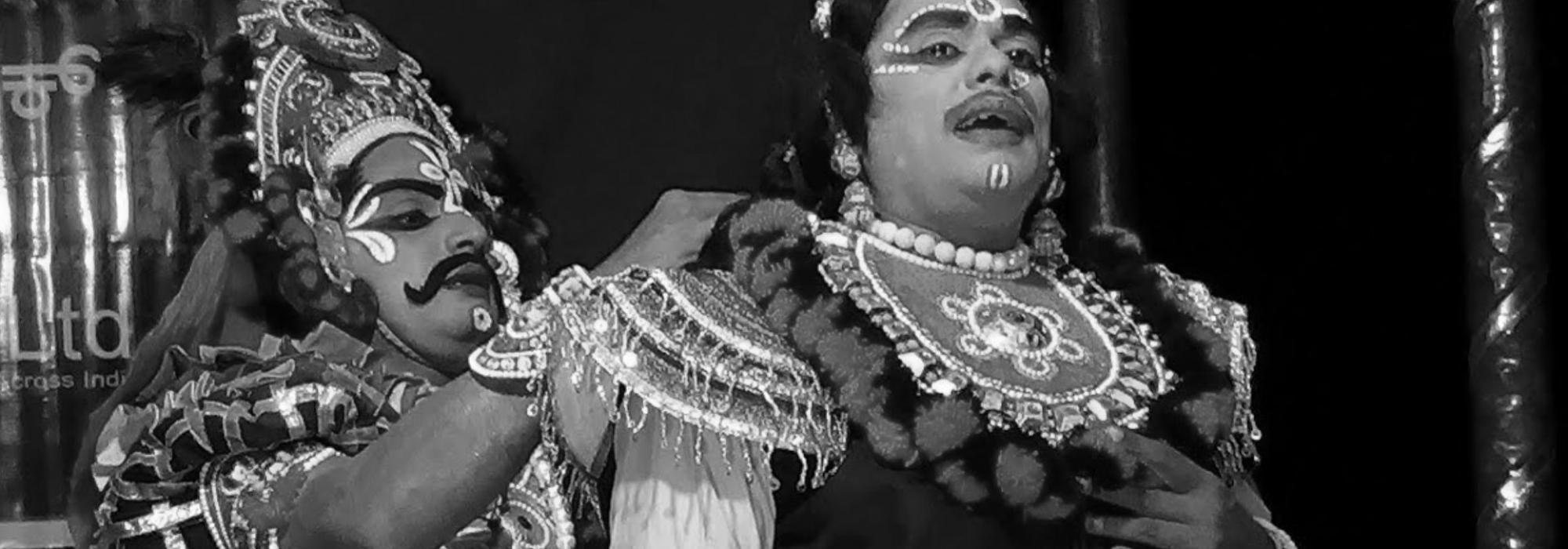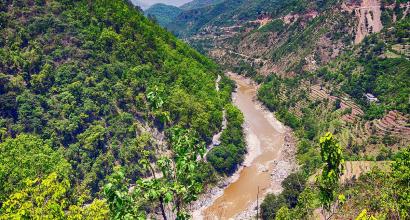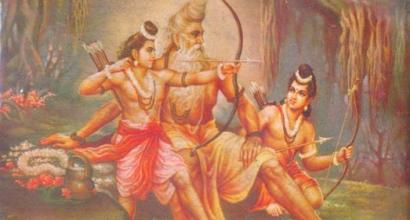Arjuna ran behind Uttara for less than a hundred steps before he caught the young man’s tuft of hair, bringing him to a halt. Uttara began whining like a person overcome by a great calamity. “I will give you a hundred coins made of pure gold; I will gift you ten elephants in rut; leave me alone Bṛhannaḍā!” he pleaded with outstretched hands. Fear had paled the reasoning and consciousness of the young prince; listening to his words and his entreaties, Arjuna smiled and led him to the chariot. He said, “O prince! If you don’t have the heart to wage war against the enemies, at least become the charioteer to one who does. Don’t fear; you’re a kṣatriya, aren’t you? I will battle the Kauravas and recover the cattle.” In this manner, Arjuna gave solace to Uttara for a while and finally made him board the chariot.
The chariot now proceeded to the śamī tree on which all the weapons were kept tied up. On the other side of the battlefield, the Kauravas were terrified of Arjuna; and if that wasn’t sufficient, several ill-omens were seen; looking at them Droṇa said, “The wind is blowing violently; the sky has become pale like it has been smeared with ash; clouds of weird shapes have filled the sky; all the weapons are sliding away and falling from their sheaths and store-houses; even during the day the jackals are screaming; the horses are shedding tears; the flags are trembling. When I see all this, it feels that war is imminent. Therefore, all of you protect yourselves and your armies; keep a strict watch on the cows; it is indeed Arjuna who has come dressed as a woman; there is no doubt about this; he will not return without waging a war; having been subjected to many pains and tribulations during the forest exile, his mind is filled with anger. O Kauravas, I don’t see who can face him in battle! It is said that even Mahādeva was impressed by his prowess!”
Karṇa heard these words and told Droṇa, “You’re always like this; you go on praising Arjuna in our presence; that eunuch is not Arjuna; and Arjuna’s knowledge is not even a fraction of the complete knowledge that I or Duryodhana have.”
Duryodhana said, “Karṇa, if that is indeed Arjuna then my work is as good as done; having recognized him, another twelve years of forest exile awaits them. If that is not the case and he’s just some eunuch, then I will destroy him in battle and bury him in the ground! Be quiet.”
As soon as the chariot reached the base of the śamī tree, Arjuna told Uttara, “Quickly climb this tree and bring down the bow that is tied there; your bow is insufficient for my strength; atop this tree, the Pāṇḍavas have tied their weapons.”
In response Uttara said, “I’ve heard that a corpse was tied to this tree; being a prince, how can I touch that? If I touch a corpse, wouldn’t I be defiled?”
Arjuna said, “O prince, don’t worry, you will not be defiled; what lies there is not a corpse but bows and arrows; will I allow the king’s son to come in contact with a corpse? Don’t fear, climb the tree!” Thus he ordered the young prince.
Without any option, he got down from the chariot and climbed the tree. Seated in the chariot, Arjuna ordered him, “Yes, untie those knots! There!” Upon untying the knots, the Gāṇḍīva and four other bows, quivers full of arrows, and swords came into view. The bows looked like hooded snakes to him; seeing them, Uttara was overcome by fear; he experienced horripilation; he repeatedly touched the weapons and was astounded to feel their weight and see their lustre; describing all the weapons one by one, filled with curiosity, he began asking Bṛhannaḍā, whose bow is this, whose arrows are there, whose sword is this.
Arjuna said, “What you asked me first, that is the Gāṇḍīva – Arjuna’s world-famous bow.” Then he told him about the other weapons that were tied there and the names of those who wielded the weapons.
Uttara asked, “Does this belong to the great Pāṇḍavas? If that is the case, where are those heroes now? After they gambled and lost their kingdom, I don’t know what happened to them! That jewel among women, the famed Draupadī, where is she? I heard that she too followed the Pāṇḍavas into the forest.”
Arjuna said, “I am Arjuna; the courtier in the assembly who plays dice is Yudhiṣṭhira; the cook Ballava employed in your father’s service is Bhīmasena; Nakula is the one who takes care of your steeds; Sahadeva is the one who tends to your cows; and Sairandhrī is Draupadī; and it is because of her that Kīcaka was killed!”
Listening to these words, Uttara approached Arjuna and said, “O Dhanañjaya! Bhumiñjaya Uttara offers his respects to you; it is my good fortune that I have obtained the gift of meeting you. Let me welcome you! O mighty-armed warrior, forgive those words of mine that I spoke in ignorance; you are a person who has accomplished impossible feats. Therefore all my fear has been dispelled.” He expressed his joy and his affection towards Arjuna. He continued, “There is just one thing that I fail to understand; how did a great warrior like you, endowed with such a form and such a powerful body, end up becoming a eunuch?”
Arjuna replied, “O prince, I am not really an impotent eunuch; according to the orders of my elder brother, I spent this year as a brahmacārī; I was helpless in the face of duty; but now that vow is over; I can now present myself in the open; therefore, I shall wage this war, fear not!” With these words, Arjuna assuaged the fears of the prince.
Uttara was filled with enthusiasm and said, “Will a eunuch ever be like this? Now my doubts have been cleared; I am imbued with fresh courage; I shall support you even if you choose to fight with the gods; what shall I do, order me! I have been trained in the art of horse-riding; I can be an able charioteer; the horse that is yoked to the right side of this chariot is like the famed horse called Sugrīva; when he begins trotting, nobody will be able to see his feet touching the ground; the horse yoked to the left is akin to the famed horse Meghapuṣpa in matters of speed; even the horses yoked in the back are similarly powerful and speedy. You alone are capable of engaging in combat while riding on this chariot pulled by such fine horses!”
Soon after this, Arjuna pulled out the bangles from his wrist and threw them away; he lifted his hair and tied it with a white cloth; he strung his Gāṇḍīva and plucked at it, making a powerful twang. A great noise arose akin to a mountain crashing against another; the earth trembled; the wind became turbulent; even huge trees shook violently and all the birds that were taking shelter in those trees flew away in great confusion in various directions; the sound that resembled thunder must be from the twang of Arjuna’s bow – thus the Kauravas surmised when they heard the sound. After that, Arjuna did a pradakṣiṇa around the śamī tree, took all his weapons, and boarded the chariot. Lowering the lion flag from the chariot and placing it at the root of the tree, he tied his own flag with the mark of a monkey – the vānaradhvaja. He donned his armour, took his bow and his quiver of arrows, made Uttara his charioteer, went in a northward direction, and blew his conch once. Upon listening to that sound, the horses trembled in fear. Uttara was overcome by shock and fear; he sat motionless in the chariot, befuddled by the sound. Looking at this, Arjuna held the reins of the chariot and steadied the horses. He embraced Uttara and said, “Don’t fear, O prince! Being a kṣatriya, can your limbs shake in the midst of the battlefield, surrounded by enemies! You’ve been in a battle before – in the midst of the assembled armies, you’ve heard the sound of conch shells, kettle drums, and the trumpeting of elephants! That being the case, upon listening to this conch of mine, why have you sat down in fear like an ordinary man?” Arjuna offered solace to Uttara with these words.
Uttara said, “On numerous occasions earlier I have heard the sound of conch shells, kettle drums, and elephant roars; but I had never heard the sound of such a conch earlier; listening to this as well as the twang of the Gāṇḍīva has deafened my ears; my mind is turbulent and I’m unable to tell one direction from another.”
“Now, sit firmly on one side of the chariot with your legs pressing against it; grasp the reins firmly, pulling it tight; I am going to blow my conch again!” said Arjuna. With this word of caution, he blew his conch shell once more.
Listening to the sound of this conch and also the thundering sound made by the Gāṇḍīva, Droṇa said, “These are definitely made by Arjuna; no wonder our weapons are shorn of their lustre, our horses are bereft of enthusiasm; jackals are screaming, crows are perched upon our banners; the army looks wilted; nobody is desirous of battle; the faces have turned pale.”
To be continued…
This is an English translation of Prof. A R Krishna Shastri’s Kannada classic Vacanabhārata by Arjun Bharadwaj and Hari Ravikumar published in a serialized form. Thanks to Śatāvadhāni Dr. R Ganesh for his review and astute feedback.

















































